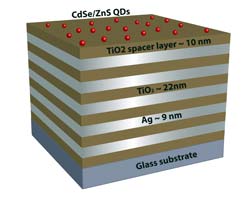'Metamaterials,' quantum dots show promise for new technologies

This graphic depicts a new "nanostructured metamaterial" - layers of silver and titanium oxide and tiny components called quantum dots - to dramatically change the properties of light. Researchers are working to perfect the metamaterials, which might be capable of ultra-efficient transmission of light, with potential applications including advanced solar cells and quantum computing. Findings and this image appeared in the journal Science in April. (Image courtesy of CUNY)<br>
The metamaterial – layers of silver and titanium oxide and tiny components called quantum dots – dramatically changes the properties of light. The light becomes “hyperbolic,” which increases the output of light from the quantum dots.
Such materials could find applications in solar cells, light emitting diodes and quantum information processing far more powerful than today's computers.
“Altering the topology of the surface by using metamaterials provides a fundamentally new route to manipulating light,” said Evgenii Narimanov, a Purdue University associate professor of electrical and computer engineering.
Findings were detailed in a research paper published April 13 in the journal Science.
Such metamaterials could make it possible to use single photons – the tiny particles that make up light – for switching and routing in future computers. While using photons would dramatically speed up computers and telecommunications, conventional photonic devices cannot be miniaturized because the wavelength of light is too large to fit in tiny components needed for integrated circuits.
“For example, the wavelength used for telecommunications is 1.55 microns, which is about 1,000 times too large for today's microelectronics,” Narimanov said.
Nanostructured metamaterials, however, could make it possible to reduce the size of photons and the wavelength of light, allowing the creation of new types of nanophotonic devices, he said.
The work was a collaboration of researchers from Queens and City Colleges of City University of New York (CUNY), Purdue University, and University of Alberta. The experimental study was led by the CUNY team, while the theoretical work was carried out at Purdue and Alberta.
The Science paper is authored by CUNY researchers Harish N.S. Krishnamoorthy, Vinod M. Menon and Ilona Kretzschmar; University of Alberta researcher Zubin Jacob; and Narimanov. Zubin is a former Purdue doctoral student who worked with Narimanov.
The approach could help researchers develop “quantum information systems” far more powerful than today's computers. Such quantum computers would take advantage of a phenomenon described by quantum theory called “entanglement.” Instead of only the states of one and zero, there are many possible “entangled quantum states” in between.
The research has been funded by the National Science Foundation and the U.S. Army Research Office.
Writer: Emil Venere, 765-494-4709, venere@purdue.edu
Source: Evgenii Narimanov, 765-494-1622, enarimanov@gmail.com
Note to Journalists: A copy of the research paper is available by contacting Emil Venere at 765-494-4709, venere@purdue.edu
ABSTRACT
Topological Transitions in Metamaterials
Harish N S Krishnamoorthy,1,2* Zubin Jacob,3* Evgenii Narimanov,4 Ilona Kretzschmar,5 Vinod M. Menon1,2†
1Department of Physics, Queens College, City University of New York (CUNY)
2Department of Physics, Graduate Center, CUNY
3Department of Electrical and Computer Engineering, University of Alberta,
4Birck Nanotechnology Center, School of Electrical and Computer Engineering, Purdue University
Light-matter interactions can be controlled by manipulating the photonic environment. We uncovered an optical topological transition in strongly anisotropic metamaterials that results in a dramatic increase in the photon density of states—an effect that can be used to engineer this interaction. We describe a transition in the topology of the iso-frequency surface from a closed ellipsoid to an open hyperboloid by use of artificially nanostructured metamaterials. We show that this topological transition manifests itself in increased rates of spontaneous emission of emitters positioned near the metamaterial. Altering the topology of the iso-frequency surface by using metamaterials provides a fundamentally new route to manipulating light-matter interactions.
Media Contact
More Information:
http://www.purdue.eduAll latest news from the category: Materials Sciences
Materials management deals with the research, development, manufacturing and processing of raw and industrial materials. Key aspects here are biological and medical issues, which play an increasingly important role in this field.
innovations-report offers in-depth articles related to the development and application of materials and the structure and properties of new materials.
Newest articles

Webb captures top of iconic horsehead nebula in unprecedented detail
NASA’s James Webb Space Telescope has captured the sharpest infrared images to date of a zoomed-in portion of one of the most distinctive objects in our skies, the Horsehead Nebula….

Cost-effective, high-capacity, and cyclable lithium-ion battery cathodes
Charge-recharge cycling of lithium-superrich iron oxide, a cost-effective and high-capacity cathode for new-generation lithium-ion batteries, can be greatly improved by doping with readily available mineral elements. The energy capacity and…

Novel genetic plant regeneration approach
…without the application of phytohormones. Researchers develop a novel plant regeneration approach by modulating the expression of genes that control plant cell differentiation. For ages now, plants have been the…





















